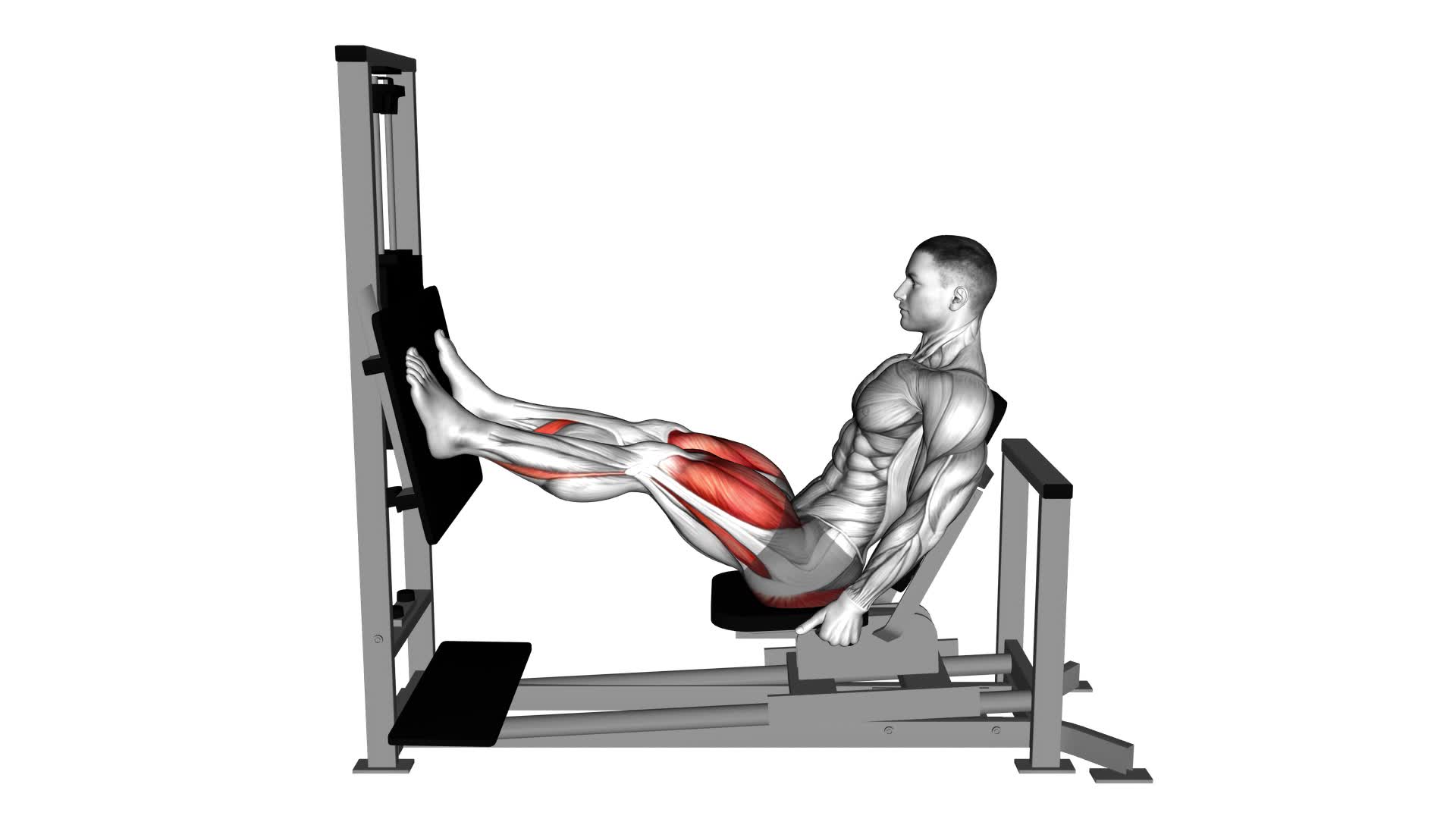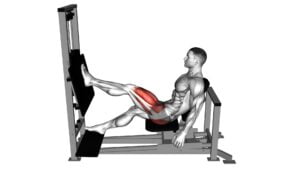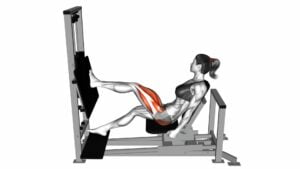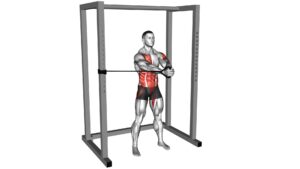Lever Horizontal Leg Press – Video Exercise Guide & Tips

Are you looking for a powerful leg exercise that targets multiple muscle groups? Look no further than the lever horizontal leg press.
Watch This Exercise Video
This video exercise guide and tips will show you the correct form, variations to target different leg muscles, and how to increase resistance and intensity.
Avoid common mistakes and ensure your safety with our precautions and safety tips.
Get ready to take your leg workout to the next level!
Key Takeaways
- The lever horizontal leg press builds lower body strength and targets multiple muscle groups including quads, hamstrings, and glutes.
- It improves overall leg power and explosiveness, enhancing athletic performance.
- The exercise helps with injury prevention by strengthening the muscles around the knees and hips.
- Proper form and technique, such as keeping the back flat against the seat and avoiding locking the knees, are essential for effective and safe execution of the exercise.
Correct Form for the Lever Horizontal Leg Press
To execute the Lever Horizontal Leg Press correctly, position yourself on the machine with your feet shoulder-width apart and your back flat against the backrest. This proper technique is essential for maximizing the benefits of the lever horizontal leg press.
When starting the exercise, ensure that your knees are bent at a 90-degree angle and your feet are firmly planted on the footplate. This position provides stability and allows for optimal muscle engagement.
To perform the movement, push against the footplate with both legs, extending your knees and hips until your legs are fully extended. Make sure to keep your core engaged throughout the exercise to maintain stability and prevent excessive strain on your lower back.
The lever horizontal leg press offers several benefits. Firstly, it targets the quadriceps, hamstrings, and glutes, helping to strengthen and tone these muscles. Additionally, it can improve lower body strength, power, and overall muscular endurance. This exercise is also joint-friendly, as it reduces stress on the knees and lower back compared to other leg exercises.
Variations to Target Different Leg Muscles
Try incorporating different foot positions to target specific leg muscles during the lever horizontal leg press.
Here are three variations you can try:
- Wide Stance: Place your feet wider than shoulder-width apart on the footplate. This variation primarily targets your inner thighs, or adductors. It can also engage your glutes and hamstrings to a greater extent.
- Narrow Stance: Position your feet close together on the footplate. This variation places more emphasis on your quadriceps, specifically the vastus medialis muscle. It can help develop the teardrop shape on the inside of your knee.
- High Foot Placement: Position your feet higher on the footplate, placing more emphasis on your glutes and hamstrings. This variation can help build strength and size in your posterior chain.
Incorporating these variations into your leg day routine can provide you with several benefits. The lever horizontal leg press allows you to target different leg muscles effectively, providing overall leg strength and development. Additionally, it helps improve your lower body stability, balance, and coordination.
To incorporate the lever horizontal leg press into your leg day routine, start with a warm-up set using lighter weights, then gradually increase the resistance for your working sets. Aim for 3-4 sets of 8-12 repetitions, focusing on proper form and control.
Remember to consult with a fitness professional if you have any concerns or questions.
Tips for Increasing Resistance and Intensity
To increase resistance and intensity during the lever horizontal leg press, incorporate these tips into your leg day routine.
- Gradually increase the weight you're lifting. Start with a weight that challenges you but still allows you to maintain proper form. As you become stronger, gradually add more weight to continue challenging your muscles.
- Perform the exercise with one leg at a time. This unilateral movement forces each leg to work independently, increasing the demand on your muscles.
- Incorporate advanced techniques such as supersets or drop sets. Supersets involve performing another exercise immediately after completing a set of leg presses, targeting the muscles from a different angle. Drop sets involve performing multiple sets with decreasing weight, pushing your muscles to fatigue.
By incorporating these tips and techniques, you can effectively increase the resistance and intensity of your lever horizontal leg press.
Now, let's move on to the next section and discuss common mistakes to avoid during the leg press.
Common Mistakes to Avoid During the Leg Press
Avoid these common mistakes to maximize the effectiveness of your lever horizontal leg press exercise. Proper leg press form is essential for targeting the right muscles and preventing injuries. Here are some common mistakes to watch out for:
- Placing your feet too high on the platform: This can put unnecessary strain on your knees and shift the focus away from your glutes and hamstrings. Instead, position your feet shoulder-width apart and place them lower on the platform, ensuring your heels stay flat.
- Locking out your knees at the top of the movement: Fully extending your legs and locking your knees can lead to joint stress and reduce muscle engagement. Instead, stop just short of locking out your knees to maintain tension in your leg muscles throughout the exercise.
- Using your lower back to push the weight: It's important to keep your back firmly against the seat and avoid arching it during the leg press. Engage your core and focus on pushing the weight with your legs, not your lower back.
By avoiding these common mistakes and maintaining proper leg press technique, you can target the intended muscles effectively and reduce the risk of injury.
Now, let's move on to the next section, where we'll discuss precautions and safety tips for the leg press exercise.
Precautions and Safety Tips for the Leg Press Exercise
To ensure your safety during the lever horizontal leg press exercise, it's important to follow these precautions and safety tips.
First and foremost, it's crucial to use the proper equipment and ensure it's in good condition before starting the exercise. Check that the machine is stable and the weight plates are securely attached.
Additionally, always start with a light weight and gradually increase the load as you become more comfortable and confident with the exercise.
Proper form is essential for injury prevention during the leg press. Keep your feet flat on the platform and shoulder-width apart. Avoid locking your knees and maintain a controlled movement throughout the exercise. It's also important to avoid excessive bending or arching of the back, as this can strain the lower back.
Another safety tip is to never use momentum or jerk the weight up during the leg press. This can lead to muscle strains or joint injuries. Instead, focus on using slow and controlled movements to effectively target your leg muscles.
Lastly, always listen to your body and stop if you experience any pain or discomfort. If you have any pre-existing conditions or injuries, it's recommended to consult with a healthcare professional before attempting the leg press exercise.
Frequently Asked Questions
How Many Sets and Repetitions Should I Do When Performing the Lever Horizontal Leg Press?
To get the most out of the lever horizontal leg press, it's important to know how many sets and repetitions are recommended.
This exercise is effective for building lower body strength. For optimal results, aim for 3-4 sets of 8-12 repetitions. However, it's crucial to listen to your body and adjust the weight and reps accordingly.
Remember to maintain proper form throughout the exercise to avoid common mistakes and prevent injury.
Can I Perform the Lever Horizontal Leg Press if I Have a Knee Injury?
If you have a knee injury, it's important to modify your leg press exercise. The lever horizontal leg press may not be suitable for you in this case.
Instead, consider alternative exercises that put less strain on your knees, such as seated leg presses or hamstring curls. These exercises can help you strengthen your leg muscles without aggravating your knee injury.
Always consult with a medical professional or a certified trainer before attempting any new exercises.
Is It Better to Use a Narrow or Wide Stance When Doing the Lever Horizontal Leg Press?
When doing the lever horizontal leg press, you may wonder whether it's better to use a narrow or wide stance. The choice depends on the benefits you seek.
A narrow stance targets the quads more intensely, while a wide stance engages the glutes and hamstrings. Optimal foot placement allows you to focus on specific leg muscles.
Consider your fitness goals and the areas you want to work on to determine the best stance for you.
Can I Use the Lever Horizontal Leg Press as a Substitute for Squats in My Leg Workout?
Yes, you can definitely use the lever horizontal leg press as a substitute for squats in your leg workout. The leg press offers similar benefits to squats, such as targeting your quadriceps, hamstrings, and glutes.
It also provides a safe and controlled movement, which can be especially helpful if you have any knee or back issues. Just make sure to adjust the weight and seat position to suit your individual needs and goals.
How Long Should I Rest Between Sets When Doing the Lever Horizontal Leg Press?
When doing the lever horizontal leg press, it's important to consider how long you should rest between sets. Rest duration can vary depending on your fitness level and goals.
Generally, it's recommended to rest for about 1 to 2 minutes between sets to allow your muscles to recover and regain strength. However, you may adjust the rest time based on your personal preference and the intensity of your workout.
Additionally, there are different exercise variations you can try to target specific muscles in your legs.
Conclusion
In conclusion, the lever horizontal leg press is an effective exercise for targeting the leg muscles. By maintaining correct form and using variations to target different muscle groups, you can increase resistance and intensity.
It's important to avoid common mistakes and follow safety precautions while performing this exercise. Incorporating the lever horizontal leg press into your workout routine can help strengthen and tone your lower body.

Author
Years ago, the spark of my life’s passion ignited in my mind the moment I stepped into the local gym for the first time. The inaugural bead of perspiration, the initial endeavor, the very first surge of endorphins, and a sense of pride that washed over me post-workout marked the beginning of my deep-seated interest in strength sports, fitness, and sports nutrition. This very curiosity blossomed rapidly into a profound fascination, propelling me to earn a Master’s degree in Physical Education from the Academy of Physical Education in Krakow, followed by a Sports Manager diploma from the Jagiellonian University. My journey of growth led me to gain more specialized qualifications, such as being a certified personal trainer with a focus on sports dietetics, a lifeguard, and an instructor for wellness and corrective gymnastics. Theoretical knowledge paired seamlessly with practical experience, reinforcing my belief that the transformation of individuals under my guidance was also a reflection of my personal growth. This belief holds true even today. Each day, I strive to push the boundaries and explore new realms. These realms gently elevate me to greater heights. The unique combination of passion for my field and the continuous quest for growth fuels my drive to break new ground.







